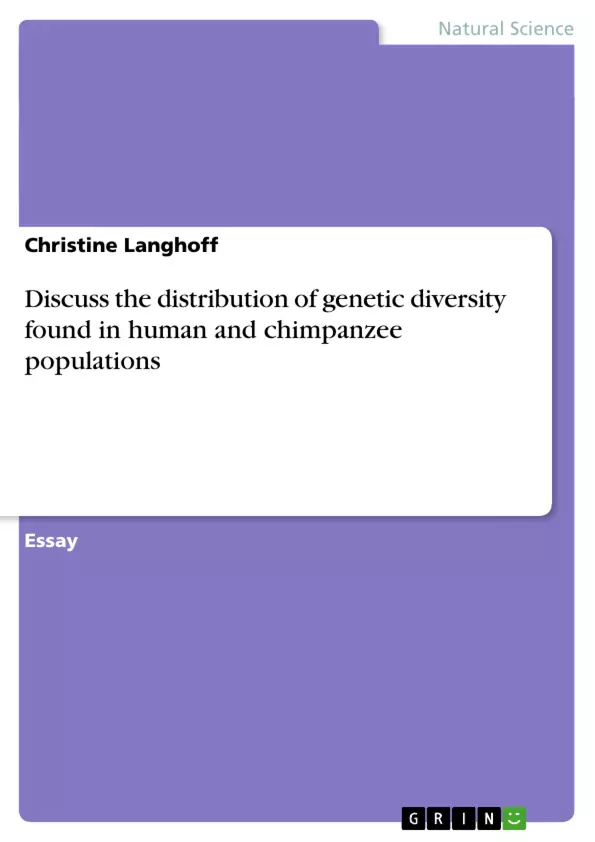Discuss the distribution of genetic diversity
found in human and chimpanzee populations
by
Christine Langhoff
In the mid-1980s one of the most important studies by Sibley and Ahlquist on our relationship to apes and monkeys found that our closest relatives are the chimpanzees and the bonobos. The study of genetic diversity within both human and chimpanzee populations has been of major interest as researchers have been and are still trying to find out about the differences in genetic diversity between the two otherwise so closely related species. The genetic diversity refers to the amount of genetic variation found in a population. It has been discovered that chimpanzees have a greater total genetic diversity than humans, but that there are exceptions such as in the major histocompatibility complex in which chimpanzees display a low genetic diversity. I am going to explore how the total genetic diversity is surveyed in and distributed among human and chimpanzee populations and I am going to compare their levels of total diversity. I am also going to explore whether different types of polymorphism reveal the same patterns of distribution within and among populations.
There are both experimental and statistical methods for studying genetic diversity within and between populations. The experimental methods include electrophoresis and the Polymerase Chain Reaction. Electrophoresis has mainly been used for proteins (primarily for enzymes) as it is easily determined when an enzyme has an amino acid replacement resulting in a difference in its overall mobility (i.e. an allozyme) because it will have an altered electrophoretic mobility. DNA restriction fragments can also be separated by electrophoresis and by using the Southern Blot method these can be made visible in order to be studied. Genetic differences resulting in the presence or absence of restriction sites can be identified because they change the length of characteristic restriction fragments. The polymerase chain reaction (PCR) is another method used in surveying the genetic diversity as it is extremely useful for amplifying specific DNA sequences such as the many DNA polymorphisms that are studied. (Hartl and Clark, 1997)
[...]
Inhaltsverzeichnis (Table of Contents)
- Genetic Diversity in Human and Chimpanzee Populations
- Methods for Studying Genetic Diversity
- Experimental Methods
- Statistical Methods
- Genetic Diversity in Human Populations
- Genetic Diversity in Chimpanzee Populations
Zielsetzung und Themenschwerpunkte (Objectives and Key Themes)
This text examines the distribution of genetic diversity in human and chimpanzee populations, aiming to compare their levels of total diversity and explore whether different types of polymorphism reveal similar patterns of distribution. It investigates the methods used to study genetic diversity, including both experimental and statistical approaches.
- Comparative analysis of genetic diversity in humans and chimpanzees
- Exploration of different methods for studying genetic diversity
- Investigating the distribution of genetic variation within and between populations
- Analysis of the relationship between genetic diversity and population substructure
- Examining the impact of selection and other evolutionary forces on genetic diversity
Zusammenfassung der Kapitel (Chapter Summaries)
- Genetic Diversity in Human and Chimpanzee Populations: This chapter introduces the topic of genetic diversity and outlines the key questions to be addressed in the text. It discusses the significance of studying genetic diversity in humans and chimpanzees, two closely related species.
- Methods for Studying Genetic Diversity: This chapter provides an overview of the experimental and statistical methods used to study genetic diversity. It explains techniques such as electrophoresis, the Polymerase Chain Reaction (PCR), Wright's F statistics, the HKA test, and genetic distances.
- Genetic Diversity in Human Populations: This chapter focuses on the distribution of genetic diversity in human populations. It examines studies that have used various techniques to assess the total genetic diversity in humans, including electrophoretic data, nucleotide diversity, and analyses of racial classification. It discusses the findings regarding the levels of genetic diversity observed in different human populations and the role of geographic structuring.
- Genetic Diversity in Chimpanzee Populations: This chapter explores the genetic diversity found in chimpanzee populations. It discusses the complexities of genetic diversity in chimpanzees, highlighting the differences between humans and chimpanzees in terms of subspecies, genetic diversity levels, and the role of the immune response. It presents contradictory results from studies examining the genetic diversity of the Major Histocompatibility Complex (MHC) in chimpanzees.
Schlüsselwörter (Keywords)
The key terms and concepts explored in this text include genetic diversity, population substructure, polymorphism, electrophoresis, Polymerase Chain Reaction (PCR), Wright's F statistics, HKA test, genetic distances, mitochondrial DNA (mtDNA), microsatellites, minisatellites, Major Histocompatibility Complex (MHC), human and chimpanzee populations, subspecies, and evolutionary forces.
- Quote paper
- BA (Oxon), Dip Psych (Open) Christine Langhoff (Author), 2002, Discuss the distribution of genetic diversity found in human and chimpanzee populations, Munich, GRIN Verlag, https://www.hausarbeiten.de/document/7607


